#lucrezia buti
Text

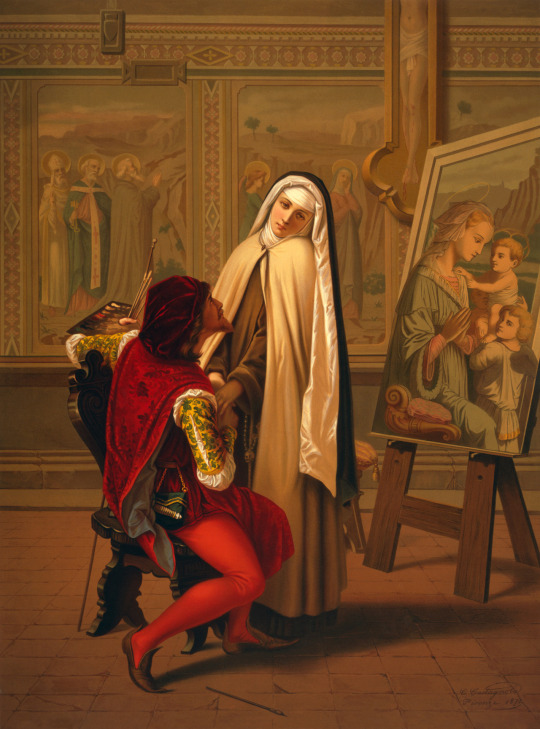
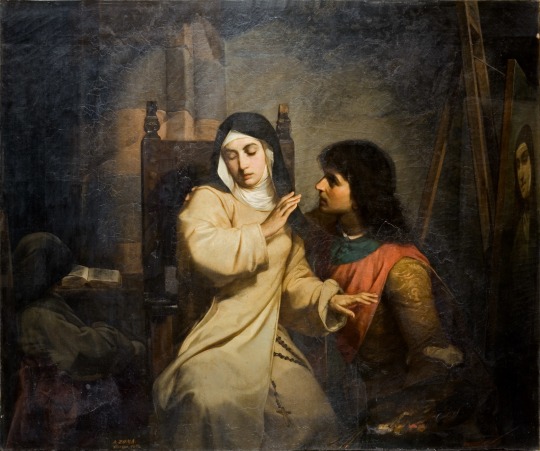
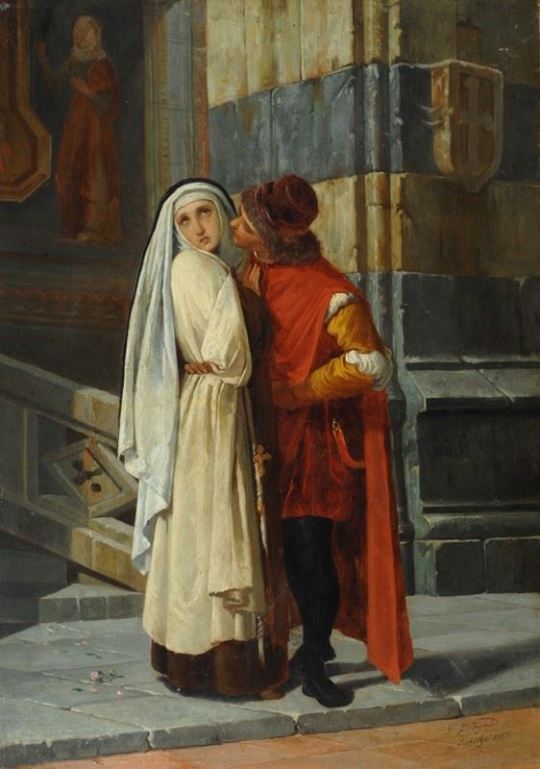
went down a rabbit hole of this subject.
Filippo Lippi, painter and carmelitan friar, and Lucrezia Buti, a nun, meet and fall in love while she poses as model for an altarpiece. Classic.
#dont be fooled by the canon of dynamic that seemed to get more artists going. she was absolutely into it#they eventually eloped together and gained the blessing of cosimo de medici to abandon their vows. they even had kids#also the painting thats in the first 2 is a famous of his but i cant find that its actually supposed to be lucrezia#the altar piece was another one. but he did draw her in other things after too. one time as salomè too#<- so jealous its unreal#art#oh but also dont be fooled by these paintings romantic approach he was not this handsome and also she was 20 and he was way older
2K notes
·
View notes
Text
Per chi abita in… Via Fra' Filippo Lippi

Le strade dedicate ad un personaggio famoso, artista o politico o scienziato sono molte, via Fra Filippo Lippi è dedicata ad un gruppo musicale. Si tratta di un gruppo musicale norvegese noto soprattutto per i singoli Shouldn't Have to Be Like That, Everytime I See You e Light and Shade, successi degli anni ottanta.

Perdonate ma da buon fiorentino non ho resistito alla battuta.
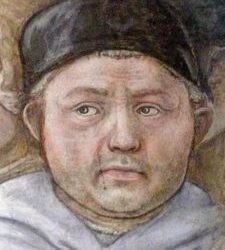
La via è, in realtà, dedicata ad un pittore protagonista della scena artistica fiorentina nella seconda metà del XV secolo.
Fra Filippo Lippi è nato nel 1406 e morto nel 1469, fu maestro e padre. Maestro di Sandro Botticelli e padre di un altro pittore presente agli Uffizi, Filippino Lippi.
Il Vasari racconta che Filippo Lippi entrò in convento all’età di otto anni presso la chiesa del Carmine dei frati carmelitani, in Oltrarno. La desinenza Fra davanti al nome è dovuta, appunto, al fatto che nel 1421 prese i voti.
Intorno al 1430 si trasferì da Firenze a Padova e qui, lui ed alcuni amici, furono rapiti dai Mori. Fatto schiavo rimase tale per oltre un anno e fu la sua mano d'artista a rendergli la libertà. Si racconta infatti che il Lippi, con un pezzetto di carbone, ritrasse il volto del suo padrone su un muro. Il padrone visto il ritratto e non conoscendo l'arte pittorica considerò l'evento miracoloso e gli concesse la libertà.
Il Lippi riuscì a rientrare a Firenze nel 1437 e aprì una bottega che entro breve si affermò grazie a commesse che arrivarono dalle più importanti famiglie della città fiorentina ed addirittura da Palazzo vecchio.
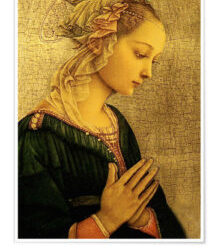
Nel 1450 ci fu il grande scandalo di Fra Filippo Lippi. Mentre lavorava ad un quadro presso il convento di Santa Margherita, dove era cappellano, necessitò di una modella per rappresentare la Madonna. La modella fu una monaca di nome Lucrezia Buti. Cappellano e monaca si innamorarono e in comune accordo Lucrezia si fece rapire da Filippo durante una processione. Nel 1457 venne alla luce il loro primo figlio, Filippino, anch'esso pittore in futuro, e poi ebbero una figlia a cui fu dato nome Alessandra. Tutto questo fu uno scandalo di proporzioni notevoli, i due entrambi con i voti, vivevano nel peccato agli occhi dell'intera comunità.
Fu Papa Pio II a risolvere il problema, su raccomandazione di Cosimo I, sciolse i loro voti. Questo doveva essere sufficiente a eliminare il peccato attraverso un matrimonio, ma i due non si sposarono e continuarono a vivere nel peccato come concubini.
Sono innumerevoli i quadri del Lippi in cui rappresenta la sua amata Lucrezia.

Jacopo Cioni
Read the full article
1 note
·
View note
Text
Il Rinascimento italiano
Firenze, Urbino, Padova, Mantova e Venezia
Firenze
Dal 1434 Cosimo de Medici governa la città con un regime di compromesso, che dà una svolta nettamente aristocratica alla cultura e ai gusti artistici cittadini: quella medicea diventa una vera e propria corte, dalla cultura elitaria neoplatonica. Ma anche la committenza privata prende nuovo slancio e la città diventa un grande laboratorio di proposte pittoriche, che si esercitano sui generi religiosi e profani più vari.
I più importanti artisti furono:
Beato Angelico (1395-1455)
Filippo Lippi (1406-1469)
Domenico Veneziano (1410-1461)
Leon Battista Alberti (1404-1472)
Di seguito sono riportate alcune delle loro più importanti opere

L' Annunciazione è un'opera di fra Giovanni da Fiesole detto Beato Angelico (tempera su tavola, 154x194 cm il pannello centrale, 194x194 compresa la predella) conservata nel Museo del Prado a Madrid e databile alla metà degli anni trenta del Quattrocento. L'opera è probabilmente la terza di una serie di tre grandi tavole dell'Annunciazione dipinte dall'Angelico negli anni trenta del Quattrocento; le altre due sono l'Annunciazione di Cortona e l'Annunciazione di San Giovanni Valdarno. La datazione non è però concorde ed alcuni storici dell'arte invertono la serie, proponendo la tavola del Prado come la prima.
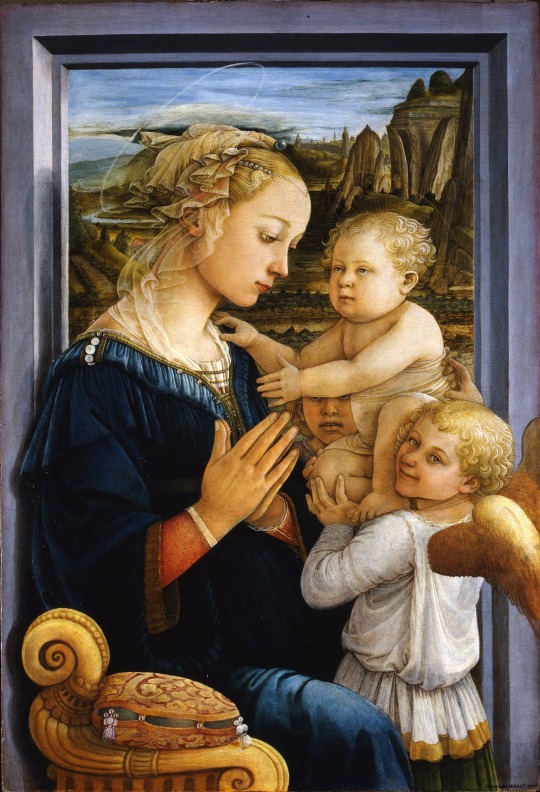
Madonna col Bambino e due angeli, di Filippo Lippi (Firenze 1406 c. – Spoleto 1469). E’ l’opera più celebre di Filippo Lippi, caratterizzata dalla straordinaria spontaneità della rappresentazione. La Madonna siede su un trono di cui si intravede solo il morbido cuscino ricamato e il bracciolo intagliato, intenta a contemplare il figlio verso il quale rivolge un gesto di preghiera. L’espressione è dolce e indulgente, ma quasi malinconica, come se la madre presagisse il doloroso destino del figlio. Il piccolo Gesù, coperto solo dalle fasce, risponde allo sguardo di Maria e protende le braccia verso di lei, sostenuto da due angeli. Quello in primo piano rivolge lo sguardo all’esterno, a coinvolgere lo spettatore, con volto sorridente. Il taglio ravvicinato, con le figure poco più che a mezzo busto raccolte nell’esiguo spazio delimitato dalla cornice in pietra serena, rende la composizione simile a numerosi rilievi scultorei eseguiti dagli scultori fiorentini coevi di Filippo Lippi. La finestra si apre davanti a un vasto e vario paesaggio affacciato sul mare, con rocce, vegetazione, edifici. L’immagine sacra è tradotta con profonda umanità, conferita sia dall’espressione degli affetti che dalla scelta delle vesti e delle acconciature, ispirate alla moda coeva: raffinatissima quella della Vergine, con una coroncina di perle e veli intrecciati ai capelli, come le nobildonne fiorentine del secondo Quattrocento. Le aureole sono appena accennate, sottili cerchi e raggi di luce che non coprono il paesaggio retrostante. Non ha finora trovato conferma l’ipotesi che il volto della Vergine sia quella di Lucrezia Buti, la giovane monaca pratese che divenne moglie di Filippo Lippi. La composizione ebbe fin da subito grande successo e fu presa a modello da molti artisti, fra i quali il giovane Botticelli, allievo del frate pittore. Non sappiamo tuttavia quale fosse l’originaria destinazione di questa immagine sacra; le prime notizie note risalgono alla fine del XVIII secolo, quando si trovava nella Villa medicea del Poggio Imperiale a Firenze.
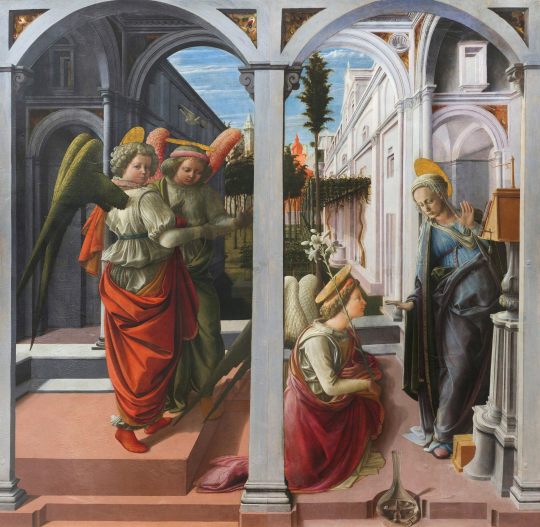
“Polittico dell’Annunciazione della Chiesa di San Lorenzo” di Filippo Lippi

Madonna col Bambino e storie della vita di sant’Anna di Filippo Lippi (Firenze 1406 ca. – Spoleto 1469), realizzato nel 1452-1453 c.
Tra le composizioni di tema sacro più originali del primo Rinascimento, il dipinto presenta in primo piano la Vergine in trono con il Bambino seduto sulle sue ginocchia, in atto di staccare chicchi dalla melagrana che la madre gli porge, simbolo di fertilità e premonizione della Passione. Alle spalle del tradizionale gruppo della Vergine col Bambino, all’interno di un palazzo, sono ambientati due episodi della vita di sant’Anna, madre di Maria. A destra sulla scala, è narrato l’incontro di Anna con il marito Gioacchino, mentre a sinistra è illustrata la nascita della Vergine, con la puerpera nel letto circondata da donne affaccendate che la accudiscono, si prendono cura della neonata e recano doni: è uno scorcio veritiero sulla vita quotidiana femminile dei ceti più abbienti nel XV secolo. Le diverse grandezze delle figure (più piccole quelle di Gioacchino e Anna nell’episodio dell’incontro, intermedie quelle dei personaggi che partecipano alla nascita di Maria e poi grandi quelle della Madonna col Bambino poste in primo piano) misurano, oltre alla profondità spaziale, la distanza temporale che separa i tre momenti. Filippo Lippi riesce ad armonizzare le singole parti della storia, narrata con straordinaria sintesi narrativa e unificata dalla complessa architettura di gusto rinascimentale. Si tende a porre in rapporto l’opera con alcuni documenti del 1452-1453 in cui Filippo Lippi risulta incaricato di eseguire un tondo per Leonardo Bartolini Salimbeni (1404-1479), verosimilmente destinato alla sua residenza: la forma circolare caratterizzava spesso le immagini sacre di destinazione domestica nel corso del Quattrocento e anche i temi rappresentati bene si addicono ad un ambito familiare. Sul retro della tavola è presente l’abbozzo di uno stemma raffigurante un grifo, finora non identificato.
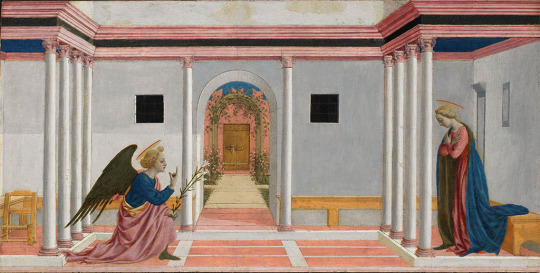
L’Annunciazione di Domenico Veneziano è la parte centrale della predella, ora smembrata, della Pala di Santa Lucia de’ Magnoli. Domenico Veneziano, Annunciazione, 1442-48, tempera su tavola, 27 x 54 cm, Fitzwilliam Museum, Cambridge.
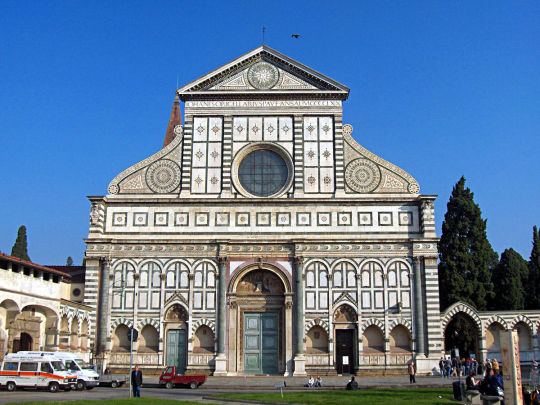
La basilica di Santa Maria Novella, la cui facciata venne restaurata da Leon Battista Alberti, è una delle più importanti chiese di Firenze e sorge sull'omonima piazza. Se Santa Croce era ed è un centro antichissimo di cultura francescana e Santo Spirito ospitava l'ordine agostiniano, Santa Maria Novella era per Firenze il punto di riferimento per un altro importante ordine mendicante, i domenicani.
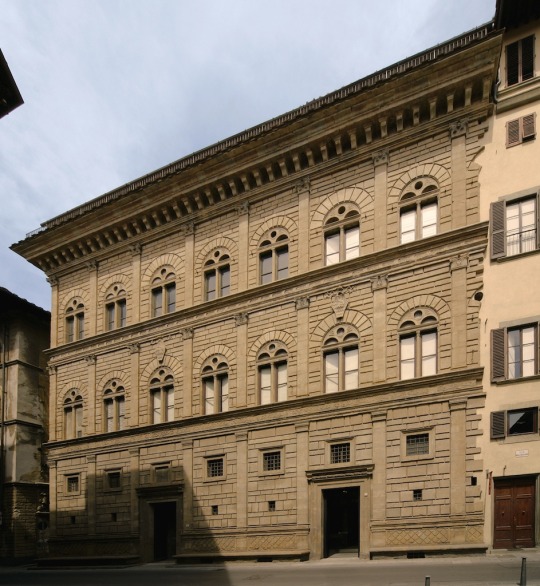
Il palazzo Rucellai è uno dei migliori esempi di architettura quattrocentesca a Firenze, posto in via della Vigna Nuova 18. La sua facciata venne progettata da Leon Battista Alberti e fu il primo di una serie di importanti interventi architettonici che l'architetto e teorico del Rinascimento eseguì per la famiglia Rucellai.
Il palazzo, commissionato dal ricco mercante Giovanni Rucellai, fu costruito tra il 1446 e il 1451 da Bernardo Rossellino, su disegno di Leon Battista Alberti, che era legato al Rucellai da amicizia e da affinità culturale. L'Alberti curò solo un intervento parziale, con gli ambienti interni composti da edifici diversi e irregolari, che richiesero una concentrazione, anziché sul volume, sulla facciata, completata verso il 1465.
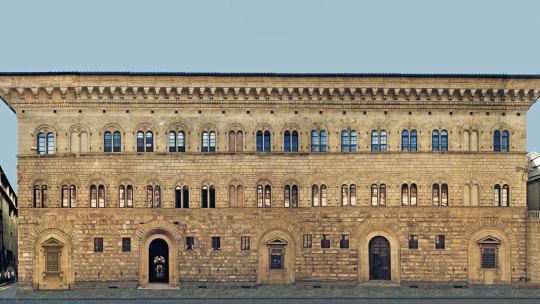
Palazzo Medici Riccardi si trova a Firenze al numero 3 di quella che per la sua ampiezza si chiamava Via Larga, oggi via Cavour, ed è l'attuale sede del Consiglio metropolitano. Il palazzo è un'opera del Michelozzo, commissionata dal patriarca delle fortune dei Medici, Cosimo il Vecchio. In un primo momento Cosimo aveva chiesto un progetto a Brunelleschi, ma, essendo un fine uomo politico, lo scartò per la sua troppa magnificenza che avrebbe senz'altro scatenato le invidie dei concittadini.
Urbino
Il Rinascimento a Urbino fu una delle declinazioni fondamentali del primo Rinascimento italiano. Durante la signoria di Federico da Montefeltro, dal 1444 al 1482, si sviluppò a corte un clima artistico fertile e vitale, grazie agli scambi culturali con numerosi centri della penisola e anche esteri, soprattutto fiamminghi. Il movimento culturale a Urbino si esauriva all'interno della corte, attorno al suo raffinatissimo principe, e pur elaborando soluzioni avanzatissime e d'avanguardia, non generò una vera e propria scuola locale, anche per il ricorso soprattutto ad artisti stranieri[1]. Nonostante ciò il linguaggio urbinate, in virtù proprio della circolazione degli artisti, conobbe un'ampia diffusione, che ne fece una delle declinazioni chiave del Rinascimento italiano. Tra le caratteristiche base della sua cultura umanistica ci furono il tono inconfondibile fatto di misura e rigore, che ebbe protagonisti come Piero della Francesca, Luciano Laurana, Giusto di Gand, Pedro Berruguete, Francesco di Giorgio Martini, Fra Diamante.
Di seguito sono riportate alcune delle più importanti opere di questi autori:

Il Palazzo Ducale di Urbino è uno dei più interessanti esempi architettonici ed artistici dell'intero Rinascimento italiano. È sede della Galleria nazionale delle Marche e del Museo Archeologico Lapidario. Infatti, il progetto più ambizioso di Federico da Montefeltro, uomo coltissimo e raffinato, fu la costruzione del Palazzo Ducale e di pari passo, la sistemazione urbanistica di Urbino, facendone la città "del principe". Prima degli interventi di Federico, la residenza ducale era un semplice palazzo sul colle meridionale, al quale si aggiungeva un vicino castellare, sull'orlo del dirupo verso la Porta Valbona.
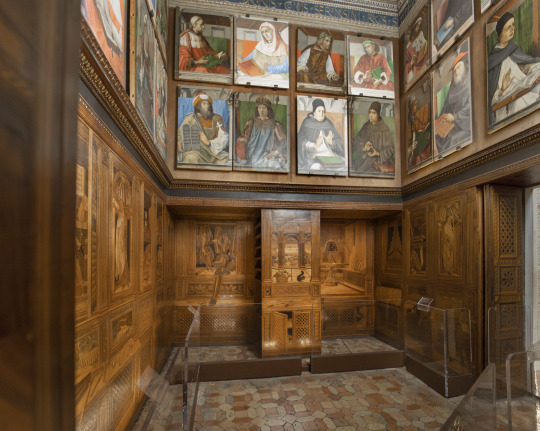
Lo Studiolo di Federico da Montefeltro è uno degli ambienti più celebri del Palazzo Ducale di Urbino, poiché oltre che essere un capolavoro di per sé, è l'unico ambiente interno del palazzo ad essere rimasto pressoché integro, permettendo di ammirare il gusto fastoso della corte urbinate di Federico. Venne realizzato tra il 1473 e il 1476, da artisti fiamminghi (Pedro Berreguete) appositamente chiamati a corte dal Duca. Con loro operarono vari artisti italiani, tra cui forse anche il celebre Melozzo da Forlì.
1 note
·
View note
Text
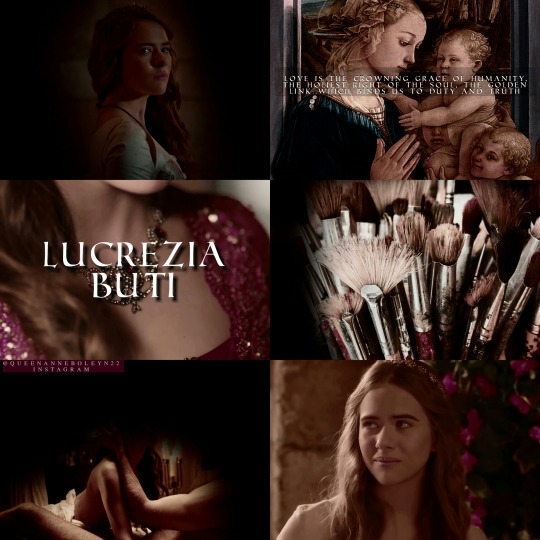
Lucrezia Buti (Florence, 1435; died in the sixteenth century) was an Italian nun, and later the lover of the painter Fra Filippo Lippi. She is believed to be the model for several of Lippi's Madonnas.
Lucrezia was born in Florence in 1435, the daughter of Francesco Buti and Caterina Ciacchi. She became a nun in the Dominican monastery of Santa Margherita in Prato. According to Vasari, while a novice or boarder at the monastery, she met the painter Fra Filippo Lippi who in 1456 had been commissioned to paint a picture for the nuns' high altar. Lippi requested Buti as a model for the Virgin in the painting he was creating for them.
Lippi fell in love with Buti during her sittings for the painting and caused a great scandal by kidnapping her from a procession of the Girdle of Thomas in Prato and took her to his nearby home. Despite attempts to force her to return to the monastery, Buti remained at Lippi's house at the piazza del Duomo.
Vasari records in his Lives of the Artists that in 1456 Fra Filippo while working in Prato, tended to frequent young women and indulge in countless romantic adventures. But it was one particularly comely young woman for whom he fell hard for.
It was in Prato while working on frescos to decorate the church of S. Margherita where he met and fell in love with the beautiful Lucrezia Buti, the daughter of Francesco Buti, a Florentine silk merchant. Lucrezia was born and raised in Florence, but after the death of her parents, Lucrezia was sent to Prato and placed under the protection of the Sisters of Santa Margherita.
The first time Fra Filippo saw Lucrezia at the convent, he thought her face exquisite, and he knew she would be the perfect model for the Madonna for his altarpiece. Right away, he asked the sisters for permission for Lucrezia to sit for him in his studio where he could paint her portrait.
In 1457, Buti bore Lippi a son, Filippino, and in 1465 a daughter, Alessandra. Through the intervention of Cosimo de' Medici, the couple received a dispensation to marry from Pius II, but according to Vasari, Lippi declined to marry Buti.
The couple remained together, and it was only several years later that Pope Pius II, thanks to the intercession of Cosimo de’ Medici, Fra Filippo, was granted an exemption to marry Lucrezia and to regularize their relationship.
Lucrezia is traditionally thought to be the model for Lippi's Madonna and Child, and Salome in his fresco cycle of the Stories of St. Stephen and St. John the Baptist in the cathedral of Prato.
#perioddramaedit#history#edit#history edit#lucrezia buti#fra filippo lippi#madonna with the child#salome#art#art history#anastasia tsilimpiou#caterina ciacchi#donne nella storia#donne italiane#donne della storia#donneitaliane#renaissance women#italian renaissance#renaissance art#women in history#francesco buti#15th century#madonna and child#filippo lippi#artist#renaissance painting#renaissance aesthetic#renaissance italy#florence#cosimo de medici
54 notes
·
View notes
Text

Madonna con Bambino, detta La Lippina
(Portrait de Lucrezia Buti)
Fra Filippo Lippi,1465
Galleria degli Uffizi, Firenze
#fra filippo lippi#la lippina#madonna con bambino#italian renaissance#art detail#white aesthetic#pearl aesthetic#blue aesthetic#pearls#light academia#aesthetic#Lucrezia Buti
5 notes
·
View notes
Photo
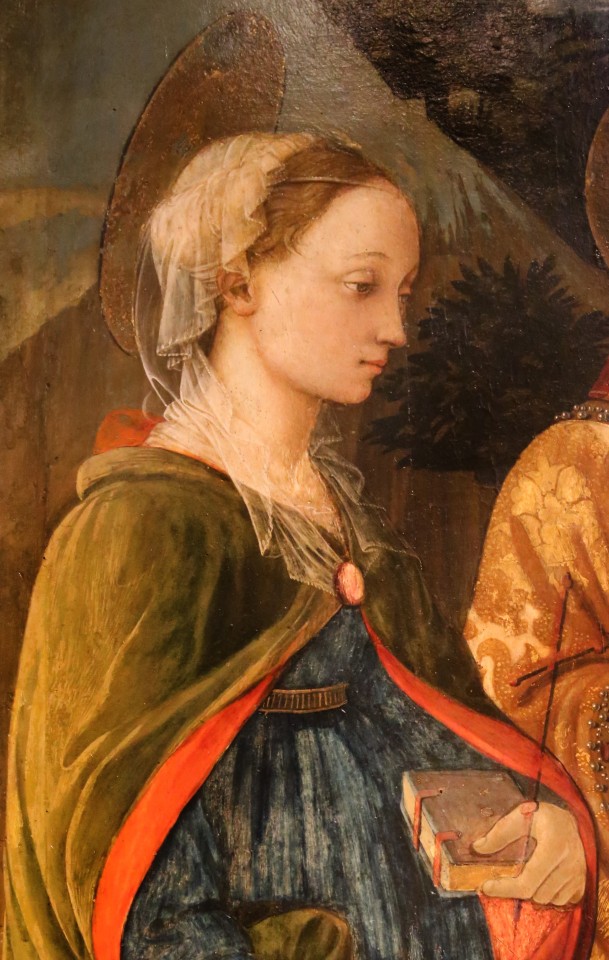
Filippo Lippi - Madonna of the Belt. Detail. 1456 - 1460
105 notes
·
View notes
Photo

historicwomendaily celebration week: Favorite Artist or Artist’s Muse
Lucrezia Buti (Florence, 1435; died in the sixteenth century) was an Italian nun, and later the lover of the painter Fra Filippo Lippi. She is believed to be the model for several of Lippi's madonnas.
Lucrezia was born in Florence in 1435, the daughter of Francesco Buti and Caterina Ciacchi. She became a nun in the Dominican monastery of Santa Margherita in Prato. According to Vasari, while a novice or boarder at the monastery, she met the painter and a chaplain to the convent in Prato Fra Filippo Lippi who in 1456 had been commissioned to paint a picture for the nuns' high altar. Lippi requested Buti as a model for the Virgin in the painting he was creating for them.
Lippi fell in love with Buti during her sittings for the painting and caused a great scandal by kidnapping her from a procession of the Girdle of Thomas in Prato and took her to his nearby home. Despite attempts to force her to return to the monastery, Buti remained at Lippi's house at the piazza del Duomo.
In 1457, Buti bore Lippi a son, Filippino, and in 1465 a daughter, Alessandra. Luckily, Lippi had powerful protectors: the Medici, for whom he painted his Annunciation (probably 1450s), now in the National Gallery. Lippi's biographer Vasari claims that Cosimo de' Medici loved Lippi despite his antics, and saw his fiery nature as typical of "rare minds". Through the intervention of Cosimo de' Medici, the couple received a dispensation to marry from Pius II.
The Virgin Mary in this most delicate and earthy of Florentine religious paintings has traditionally been identified as Lucrezia. Certainly, the same model poses as Mary in his circular, beautiful, and Two Angels with the Birth of the Virgin and The Meeting of Joachim and Anna (c1452 or mid to late 1460s) in the Pitti Palace, Florence. These two paintings stand out among Lippi's works for the emotionally involved representation of a Madonna who seems unequivocally a real woman.
Pictured: Madonna With Child and Two Angels, Filippo Lippi (c.1465)
#historyedit#lucrezia buti#fra filippo lippi#cosimo de medici#historicwomendaily#15th century#women in history#history#my edit
245 notes
·
View notes
Photo
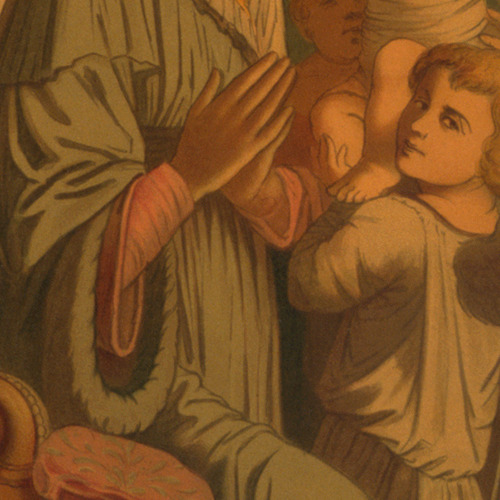
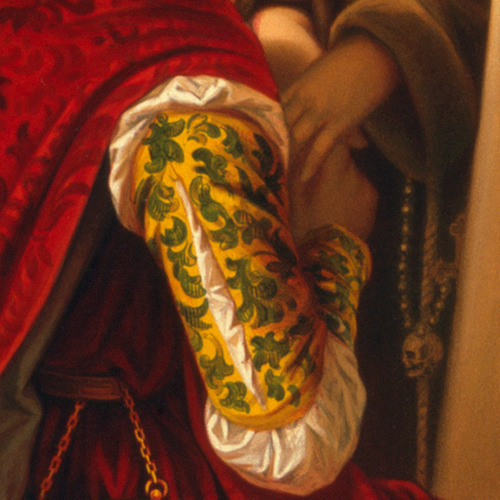

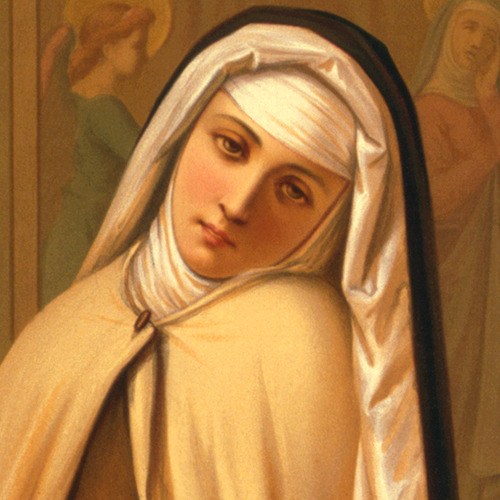
details from Love or Duty (1871), Gabriele Castagnola
#detail#painting#arthistory#1800s#academic#fra filippo lippi#lucrezia buti#love#duty#aesthetic#red#white#crem#art#edit#art edit#mine#gabriele#castagnola#19th century
296 notes
·
View notes
Photo
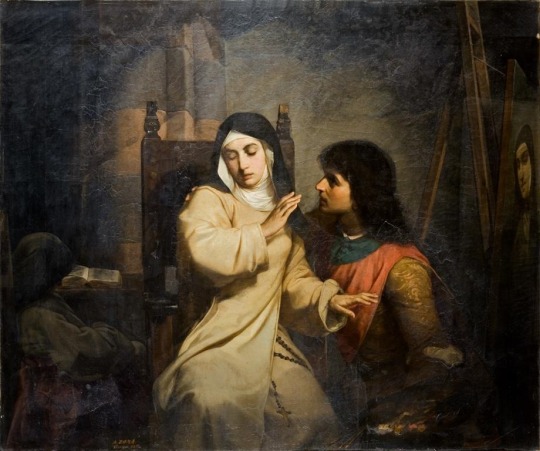
Filippo Lippi seduce la monaca Lucrezia Buti, Antonio Zona 1856.
7 notes
·
View notes
Text
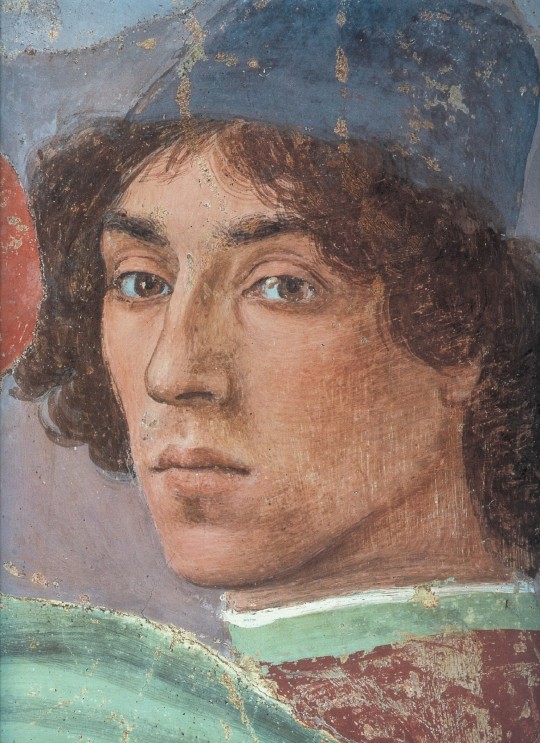
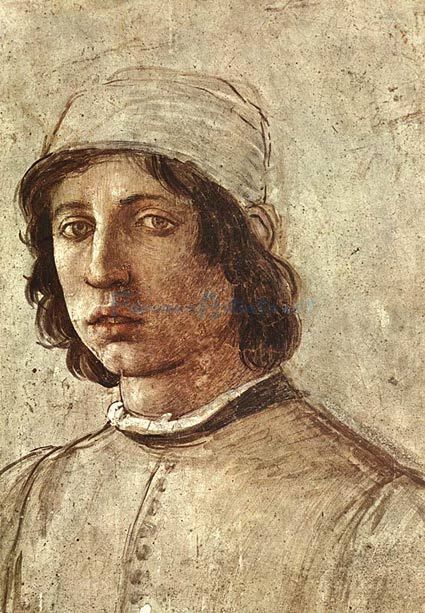
Filippino Lippi (1457-1504).
Italian painter.
.
He was an early Renaissance painter of the Florentine school whose works influenced the Tuscan Mannerists of the 16th century.
.
The son of Fra Filippo Lippi and his wife, Lucrezia Buti, he was a follower of his father and of Sandro Botticelli. After Fra Filippo Lippi’s death, Filippino entered the workshop of Botticelli. By 1473 he had finished his apprenticeship. The style of Filippino’s earliest works stems from that of Botticelli, but Filippino’s use of line is less sensitive and subtle than Botticelli’s. In a group of paintings executed about 1480–85 he developed a harder and more individual style.
.
He was employed, along with Botticelli, Perugino, and Domenico Ghirlandaio, on the frescoed decoration of Lorenzo de’ Medici’s villa at Spedaletto and at the end of 1482 was commissioned to complete work left unfinished by Perugino in the Palazzo della Signoria in Florence.
.
Soon after (probably 1483–84) he was entrusted with the completion of the frescoes in the Brancacci Chapel in the Carmine, which had been left unfinished on Masaccio’s death in 1428.
In Rome Filippino decorated the Carafa Chapel in Santa Maria sopra Minerva.
.
After his return from Rome, Filippino executed a fresco of the Death of Laocoön for the villa of Lorenzo de’ Medici at Poggio a Caiano, in which some of the decorative devices used in the Carafa Chapel are again employed, and resumed work in the Strozzi Chapel (completed 1502), the frescoes of which anticipate Tuscan Mannerism of the 16th century.
.
Because of Lippi's fame and reputation, on the day of his burial all the workshops of the city closed for him.
.
Famous works:
The Vision of St. Bernard
Tobias and the Angel
Apparition of the Virgin to St. Bernard
[Submission]
#filippino lippi#italian history#Italy#italian renaissance#renaissance#15th century#16th century#art history#renaissance art#history crush#historical hottie#history#history hottie#historical crush#history lover#historical figure#history nerd#historical babes#historical
70 notes
·
View notes
Text
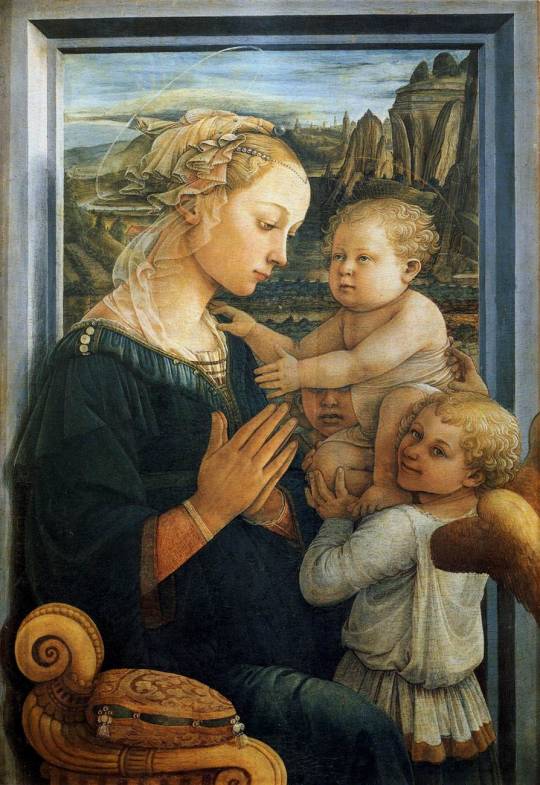

MADONNA COL BAMBINO E ANGELI
Nome🍉: Madonna col Bambino e angeli detta Lippina
Autore🍉: Filippo Lippi
Data🍉: 1465 circa
Materiale e tecnica🍉: tempera su tavola
Contesto originale🍉: A causa della mancanza di documenti contemporanei, le circostanze della committenza e la datazione dell'opera sono sconosciute. Potrebbe essere un'opera del periodo pratese poiché il viso della Madonna è tradizionalmente riferito a Lucrezia Buti. Le dimensioni invece hanno fatto formulare l'ipotesi che si potesse trattare di una celebrazione per un'occasione privata e personale dell'artista, come la nascita del figlio Filippino. Abbiamo un'iscrizione settecentesca sul retro della tavola che testimonia la presenza del dipinto nella villa di Poggio Imperiale di proprietà dei Medici. I modelli da cui il pittore trae ispirazione sono ad esempio Agostino di Duccio, Luca della Robbia e Donatello. Abbiamo anche un disegno preparatorio dell'opera, in possesso del Gabinetto dei Disegni e delle Stampe degli Uffizi
Stile e descrizione🍉: Sia la composizione che l'uso del colore sono estremamente innovatori. Il gruppo è collocato davanti ad una finestra aperta che mostra un paesaggio a volo d'uccello, ispirato dalla pittura fiamminga. La Madonna la troviamo in primo piano e nelle sue fattezze possiamo riconoscere Lucrezia Buti, monaca e amante del pittore. Ella è seduta su una seggiola e posta a tre quarti, mentre la testa è di profilo. L'estremo virtuosismo della figura è testimoniato dell'acconciatura elaborata: questo particolare viene ripreso in tutto il secondo quattrocento fiorentino. Molto elegante è anche il vestito e le perle, riprese dal Cantico dei Cantici, sono simbolo di purezza. Una novità è il taglio all'altezza del ginocchio, e la disposizione del bambino: egli infatti non è retto dalla Madonna ma dai due angeli. Molto innovativo è l'uso del colore: soltanto Leonardo seppe riprendere lo stesso effetto di unità atmosferica.
Collocazione attuale🍉: Uffizi, Firenze
1 note
·
View note
Text
Lippi’s Madonna and Child

Filippo Lippi (1406-1469)
Madonna and Child with Two Angels, 1460-1465 ca.
Tempera on wood
95x62 cm
The Uffizi Galleries
-----------------------------
Why I chose this piece
When thinking about what piece to choose, I was stuck for a few days. I felt that I did not have any objects in mind that were ‘strong enough” in their objection. Most of the art that I have studied has been within the European realm and, therefore, Eurocentric. I was not sure if a European piece would be as appropriate or powerful as a painting or sculpture from a culture that had been colonized by Europeans. However, as I thought about it more, I concluded that dismantling harmful ideas and stereotypes produced by Eurocentrism within Europe is just as crucial as dismantling them in previously colonized cultures.
I feel a deep connection to the Renaissance and Italian culture in my academic studies because of my undergraduate degree in Italian. I knew I wanted to carry what I learned during the last four years into my graduate work, and this project seemed like the perfect opportunity. There were lots of different artists and paintings that I could have chosen. There is Artemisia Gentileschi, a woman artist who rivals Caravaggio in skill and style. Or Elisabetta Sirani, another woman artist from the Renaissance who opened a painting academy for women. Their works contrast the Eurocentric norms of the time, by their status as women artists and the subjects of their art.
I chose Filippo Lippi’s piece for a few different reasons. The first is that it is my favorite painting from the Renaissance. The first time I heard the story behind the painting’s history, I was enthralled. Like the painting’s physical beauty, I thought the story was beautiful and liberating. My thoughts changed later upon hearing another version of the painting’s history, but for the most part, I still find myself caught up in the emotion of the original sentiment I studied. The second reason I chose this painting is its role in cementing some but contesting other Greco-Roman norms, many of which persist today. The Renaissance’s goal to reclaim ancient Greek and Roman culture and harmful Christian ideals created a dangerous and oppressive situation for women in the Renaissance. Since many cultures worldwide have been shaped by these same Eurocentric cultural aspects, I think the painting’s objection to women’s status at its time of creation makes it all the more powerful. Its power transcends time and is still important today.
This painting is by no means a perfect representation of Filippo Lippi or his character, as I describe in more detail below. However, I think it shows objection to religious and social ideas we abide by today, especially in Christian culture, that were seemingly cemented in the Renaissance. I also think it is an excellent piece to explore Eurocentric historicism, which I discuss below. I enjoyed revisiting my favorite Renaissance work of art, and it turned out to be the perfect piece for me in completing this project.
Reframing the object
Lippi’s Madonna and Child with Two Angels has been a symbol of resistance in my eyes since I first learned about it in my undergraduate Renaissance art history class. While the Renaissance was about breaking the rules, new rules regulated the breaking of those old rules. The push away from traditional religious iconography and imagery in the Renaissance did not mean that religious painting and sculpture commissions stopped--quite the opposite, actually. Biblical scenes and characters' secularization led to a boom in inspiration and production, with hundreds of annunciation, crucifixion, and “Madonna and child” scenes portrayed in the Renaissance style. These scenes were often inserted into a Tuscan landscape, depicting characters according to Italian beauty standards at the time.
Upon first glance, this painting may appear to be another standard “Madonna and child” from the early Renaissance. Mary, dressed in blue and seated in the foreground, adheres to the ideals of Renaissance beauty. With blond hair, a high forehead, and brown eyes, she depicts the ideal woman from this period. Her skin is also a pale cream, another ideal physical aspect of Italian society and art during the Renaissance. After the first glance, though, it becomes clear that Mary’s face is not the generic face of any particular Italian woman walking down the street. Her face is uncannily similar to the face of Lucrezia Buti, Lippi’s wife.
The act of using his wife as a model for the mother of God may not have been scandalous in and of itself. However, Lippi, an ordained priest, and Buti, a nun, had an affair that resulted in children out of wedlock. Historically, the narrative has been that Lippi kidnapped Buti during a public Catholic procession, taking her to his home in Prato, where their affair ensued. It is unclear whether the kidnapping was a front because Buti could not leave her convent, or if it was an actual kidnapping, meaning she was held against her will and raped multiple times. Most of what we know about Lippi and Buti comes from Giorgio Vasari’s The Lives of the Artists, a collection of biographies published in 1550 written about the best artists of the Renaissance. Vasari was known to exaggerate and alter stories for his dramatic literary gain. He was also a raging sexist, excluding numerous successful and famous women artists from his work. How much of Lippi and Buti’s story is true is up for debate.
Lippi and Buti’s statuses in the Catholic church made their affair extremely scandalous, even by Renaissance standards. Themes of carnality and sexual liberation were increasingly common in art and literature, but purity, modesty, and virginity remained crucial aspects of religious life. Lippi and Buti’s children, who were born out of wedlock, were proof of their Catholic faith's betrayal. As punishment, they should have been exiled from Florence at the very least. The Medici family, who ruled Florence and the surrounding villages, allowed Lippi and Buti to remain in the city and live as a typical family so long as Lippi completed painting commissions at the family’s request. With their significant political influence and artistic patronage, the Medici family acquired a special dispensation for Lippi and Buti to marry. It is unclear whether they ever did, which would have only added to the shame of their domestic and religious situation.
It is impossible to ignore the possibility that Buti may have been a victim of sexual assault in this story. If it is true, Lippi’s work cannot be separated from his status as a rapist. However, given that there is no clear evidence that he is or is not, the more common narrative that he kidnapped Buti because she could not leave the convent and that they truly loved each other has persisted. This being the standard narrative speaks volumes to the ways history is written to protect and favor men.
Using Buti as his model for Mary, Lippi smashes the expectation that women should be modest and pure. His wife, a disgraced nun and mother of bastard children, is the face of the mother of God. Lippi objected to harmful and sexist gender roles in doing this. Mary has long since been the “ideal” feminine model for women living within the Christian sphere. Her veneration, which partially stems from her virginity, has been used to keep women sexually repressed and stuck in submissive social and domestic roles.
Patriarchy and its harmful consequences cannot be separated from Eurocentrism. In reframing Lippi’s Madonna and Child with Two Angels, I would like to apply Dipesh Chakrabarty’s theory regarding Eurocentrism and historicism. If we look at this painting and the traditional narrative of Mary, Christianity, and women’s roles, it goes against Eurocentric historicism. A woman like Buti would be considered a whore to most people during the Renaissance, even though she is possibly a survivor of sexual assault.
Religion, sex, and patriarchy do not exist in a vacuum. Nor are they determined by history. We make decisions every day (conscious and unconscious) that uphold the harmful effects of negative sex representation in patriarchal religious settings, much like those in the Renaissance did. This was not because people did not “know any better.” Scholarship and rhetoric surrounding women’s rights and freedom were relatively well-circulated during the Renaissance. Books like Christine de Pizan’s The Book of the City of Ladies set forth numerous arguments for women's liberation and their various essential roles in society. Like today, people chose to use tradition and “history” to continue reinforcing harmful stereotypes, expectations, and ideals for women.
Lippi and Buti’s story is complicated. We will never know what truly unfolded nearly 600 years ago, mainly because the male-centered narrative has persisted in their case. However, Lippi’s painting does object to religious standards of the time. With his painting, a woman can be held with the highest regard, regardless of her sexual past. It goes against the Eurocentric patriarchal tradition and breaks away from the European historicism that claims women’s treatment was shaped solely upon the cultural norms of the past that peristed in the Renaissance. This piece is one of the most famous works from the Renaissance, and it is still widely celebrated today. Its place in art academia makes it a piece of persisting resistance that can serve as inspiration to break away from gender norms in religion and society today, as Lippi and Buti did so many years ago.
--Darian Rahnis
1 note
·
View note
Photo
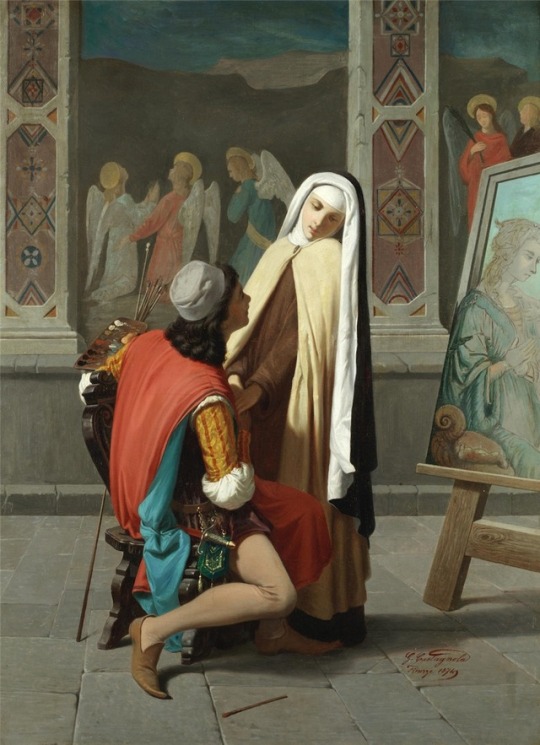

Gabriele Castagnola (1828-1883) Fillipo Lippi tailling in love with Lucrezia Buti. 1873
174 notes
·
View notes
Photo
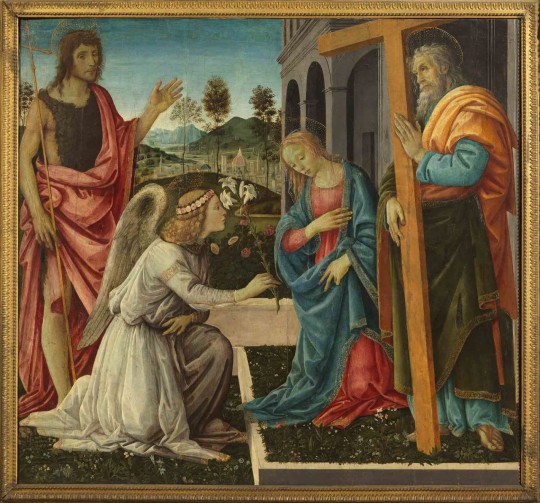
~ Among the most talented painters of the Renaissance in Florence, Filippino Lippi was born from the forbidden relationship between Fra Filippo Lippi, the great master of the early Florentine Renaissance, and the nun Lucrezia Buti. Filippino shows in his first works the influence of the one who was his teacher, Sandro Botticelli, in whose workshop Lippi completes his apprenticeship. This influence is testified in this Annunciation and the recently restored Saints John the Baptist and Andrew in both the central and lateral figures represented by Filippino. However, the painting - dated 1483 - belongs to the author's period of maturity and this is very evident if one observes the lively use of color, the serene dialogue that is established between the characters and the sense of general harmony that emerges from the painting. The Archangel Gabriel kneels gently before the Madonna who meets her heavenly host with balance and humility. On the left, St. John the Baptist slightly raises his left arm, indicating with his hand to the viewer that a sacred encounter is in progress. Saint Andrew contemplates the action, while embracing the cross with both hands, an attribute of his martyrdom. The vibrant colors and the crystalline atmosphere infuse the scene with a supernatural calm, while the deep folds of the garments give solidity to the figures. The scene takes place outdoors in the bright Florentine countryside. In the background we can distinguish both Brunelleschi's dome from the Duomo and Giotto's bell tower on the left. The four sacred figures are placed within a lush garden, full of flowers and green grass, perhaps to underline Filippino's interest in Flemish painting that had spread to Florence during this period. Museum of Capodimonte, Naples. ~
1 note
·
View note
Text
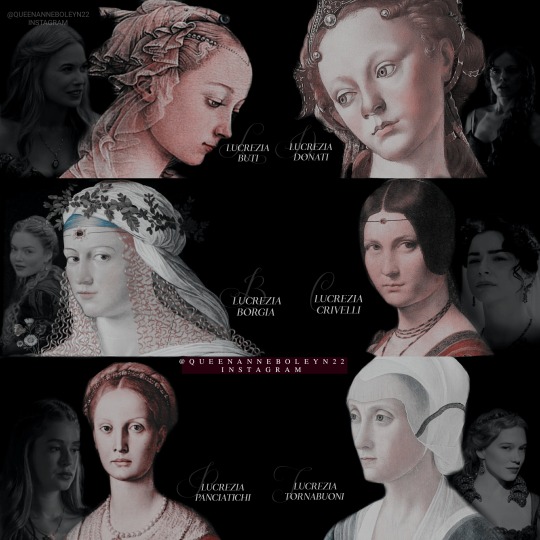
• renaissance women named "Lucrezia "•
#lucrezia borgia#lucrezia tornabuoni#lucrezia donati#lucrezia buti#lucrezia panciatichi#lucrezia crivelli#italian renaissance#renaissance women#renaissance italy#renaissance#histroy#historical#history#art#history edit#edit
120 notes
·
View notes
Photo
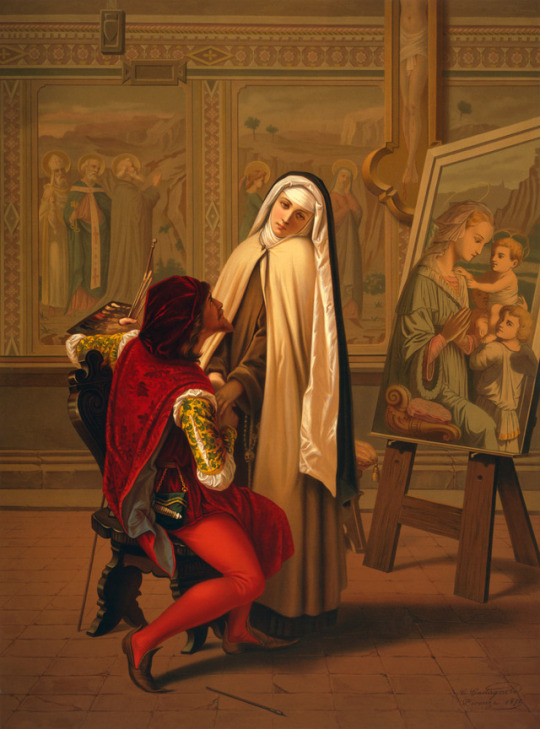
Gabriele Castagnola, Love or duty, 1873
This painting depicts the love affair between the Italian Renaissance painter Filippo Lippi (1406-1469) and the novice Lucrezia Buti (1435-?). He used her as a model for one of his most famous Virgin and child, which led them to have sexual relations despite the fact she was reclaimed by her convent (and despite the fact he used to be a priest himself). They eventually married, and this relationship resulted in their son, Filippino Lippi, who became a famous painter following his father.
625 notes
·
View notes